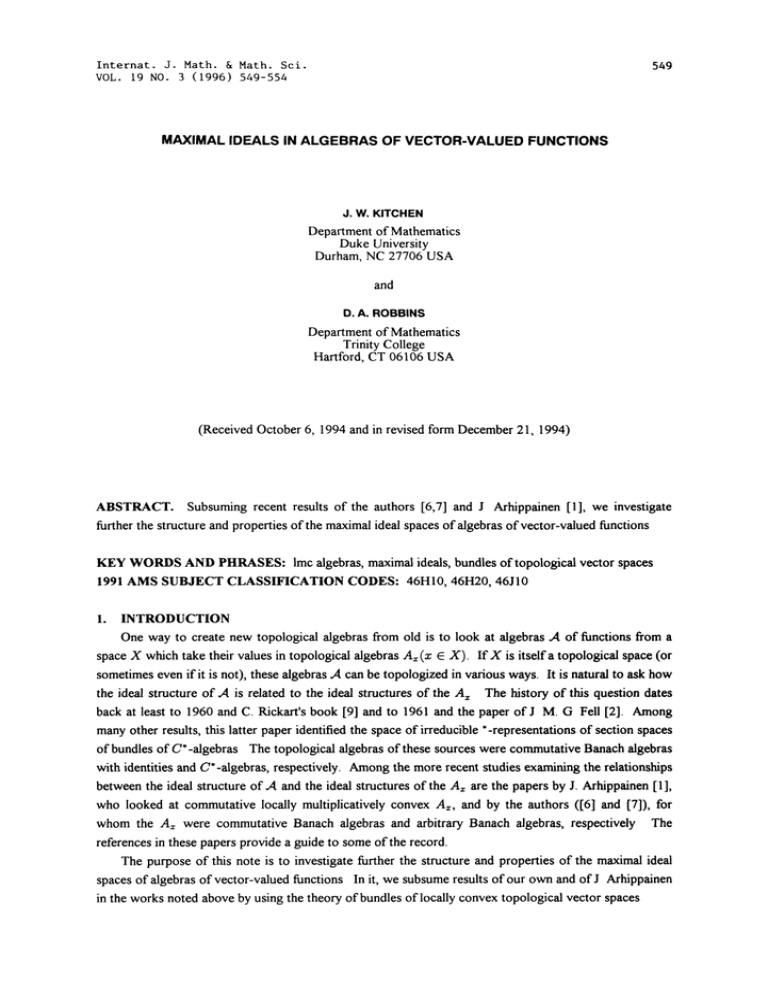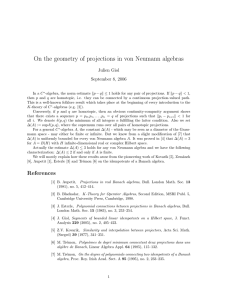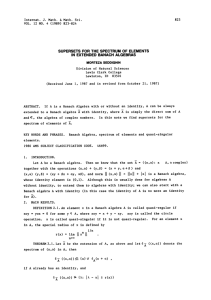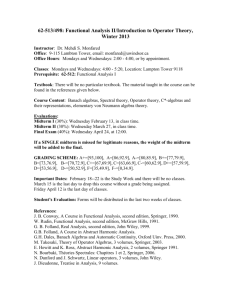MAXIMAL w.
advertisement

Internat. J. Math. & Math. Sci.
VOL. 19 NO. 3 (1996) 549-554
549
MAXIMAL IDEALS IN ALGEBRAS OF VECTOR-VALUED FUNCTIONS
J. w. KITCHEN
Department of Mathematics
Duke University
Durham, NC 27706 USA
and
D. A. ROBBINS
Department of Mathematics
Trinity College
Hartford, CT 06106 USA
(Received October 6, 1994 and in revised form December 2 l, 1994)
ABSTRACT. Subsuming recent results of the authors [6,7] and J Arhippainen [l], we investigate
further the structure and properties of the maximal ideal spaces of algebras of vector-valued functions
KEY WORDS AND PHRASES: lmc algebras, maximal ideals, bundles of topological vector spaces
1991 AMS SUBJECT CLASSIFICATION CODES: 46H10, 46H20, 46J10
INTRODUCTION
One way to create new topological algebras from old is to look at algebras ,A of functions from a
space X which take their values in topological algebras Ax (z E X). If X is itself a topological space (or
sometimes even if it is not), these algebras .A can be topologized in various ways. It is natural to ask how
the ideal structure of .A is related to the ideal structures of the A The history of this question dates
back at least to 1960 and C. Rickart’s book [9] and to 1961 and the paper of J M. G Fell [2]. Among
many other results, this latter paper identified the space of irreducible *-representations of section spaces
of bundles of C*-algebras The topological algebras of these sources were commutative Banach algebras
with identities and C*-algebras, respectively. Among the more recent studies examining the relationships
between the ideal structure of 4 and the ideal structures of the Ax are the papers by J. Arhippainen ],
who looked at commutative locally multiplicatively convex A:, and by the authors ([6] and [7]), for
whom the A were commutative Banach algebras and arbitrary Banach algebras, respectively The
references in these papers provide a guide to some of the record.
The purpose of this note is to investigate further the structure and properties of the maximal ideal
spaces of algebras of vector-valued functions In it, we subsume results of our own and of J Arhippainen
in the works noted above by using the theory of bundles of locally convex topological vector spaces
1.
2.
IDENTIFICATION OF MAXIMAL IDEALS
Consider the following stuation let X be a completely regular Hausdorff topological space, and
denote by Ct,(X) the space of bounded and continuous complex-valued functions on X Let
/A, "x E X) be a family of non-trivial commutative locally multiplicatively convex (lmc) algebras
ndexed by X Let A be the disjoint umon
x E X) of algebras (which can, if we like, be thought
of as the set
x({Xt A, )), and let 7r A X be the natural surjection Assume further that we
have on the fibered space A a family of seminorms {,,
.9} such that, for each x
(where ,’ is the restriction of to AT) is a family of submultiplicative seminorms which generates the
topology on A, Assume, finally, that we have an algebra .A of selections (-- choice functions)
(7:X
A such that
1) for each x X, ev,(.A) {(7(x) (7 E .A} A (in this case,.A is said to be full).
2) .,4 is a C (X )-module. and
.5, the numerical function x u,((7(x)) is upper
3) for each (7 ,4 and for each
,,
O{A,
,,
semicontinuous on X
Before going farther, we point out two special cases of this situation If X is compact, and if each
A is a commutative Banach algebra (and the set A is a singleton), then we have the situation in [6] On
the other hand, if B is a commutative lmc algebra, and if.,4 C(X, B) is the algebra of all continuous
B-valued functions on X (so that A B for all x X), then we have the situation described in [1]
Returning now to the general situation, we make .A into a commutative lmc algebra First, we select
of X which is closed under finite unions For each K
and E .,q we
define a seminorm pr, on .A by pr,((7)= sup v((7(z)) Then the PK., are easily seen to be
submultiplicative, so that they generate an lmc topology on .,4 The sets
’
a compact cover
V(,K,,)
{- A: .(- -) < }
,,
form a subbasic system of neighborhoods of a ,4 as K
E J, and every e > 0 vary
Note that different choices of covers 6may lead to different topologies on .,4 In the constant fiber
be the family of all compact subsets of X. in which
case .A C(X, B), described above, we can let
has the compact-open topology (the topology of uniform convergence on compact subsets of
case
X) If, at the other extreme, we let d’be the family of finite subsets of X, then .At has the topology of
pointwise convergence on X
In the general case, we note further that since A with the given topology is an lmc algebra, the
multiplication on ,4 is (jointly) continuous in the topology given by the seminorms Pg., (see [8])
Moreover, if we endow Cb(X) with the sup norm topology, it is easily seen that the module
multiplication (f,a)- fa from C,(X) A to A is also jointly continuous, so that A is in fact a
topological Cb (X)-module
let JIK {alK a J}, where crlK denotes the restriction of
For a subset J c ,A and K
a to K. Denote the restriction map by restr A
PROPOSITION 1. Suppose that J C AlS an 1deal in A which is also a Cb(X)-module of
Then J K is an ideal in A IK which is also a C (K)-module.
PROOF. Evidently, JIK is an ideal in .AIK
Let a J, and let f C(K) We may extend f to f* C(X), see [4, p 90] Then
restK(f*a)
since f* a E J
IZI !-11"!
restK(f*) restK((7)
f (crlK) .ILK,
MAXIMAI.
ll)IiAI,S
5.51
IN AI,(;I.IRAS ()1: VlrC 1()R-VAIAJI.:I) I:t.INCTI()NS
PROPOSITION 2. Suppose thai J C ‘4 t.s" a Ct,(X)-.submodule and a closed proper Meal. lhen
there exlsI.s z E X such thai ev, (J) J, Is" a chzs’edproper Meal m A,.
PROOF. Fix K E 3(, and consider .,41K This is a space of choice functions over K, whose
seminorm functions :c
u; (a(x))(a .4, .,0) are then upper semicontinuous over K by restriction,
and hence bounded on K By [3, Theorem 5 9, p 49], there is a bundle 7rc AK--* K of lmc
topological algebras such that 1-’(Tr K) ‘41K, the topology on AIK is generated by the PK,
Suppose now that for each zX, we have J =A,, and let oE‘4 We will show that every
J, contrary
neighborhood V of contains an element 7- J Since J is closed, this will show that
to the assumption that J is a proper ideal in ‘4 We may assume that V is of the form
V
( V(,K, ip,),
p
where the z’s are indices in .; From the preceding, JIK is a C(K)-submodule of‘4lK F(zrh-) such
that ev (JIK) is dense in each A (x E K) Then, using [3, Theorem 4 2, p 39], J[K is dense in
By the definition of the topology on ‘41K, this means that there is a 7- E J such that pr.,;(r 7-) < e for
n But this says precisely that 7- E V E]VIV!
p 1
PROPOSITION 3. Suppose that H" .At C s a non-trivial contmuous multphcatve
homomorphsm; set J ker H. ]hen there exists x X such that J is a proper ideal In Az.
PROOF. It suffices to show that J is a Cb(X)-submodule of‘4 If it is not, we may choose a J
and f Cb(X) such that f J Since J is in any event an ideal, we have (re)2 (fa) j But
H((fa) 2) [H(f)] # 0, a contradiction I-il-II-I
space of non-trivial continuous
PROPOSITION 4. Let /x,(‘4) be the Gelfand space of .At
homomorphsms H" .,4 C). If H /x,(‘4), then there exist x X, h /k(Az) such that H h o ev.
PROOF. Let H E/k(A), set J ker H, and choose x E X such that J is a proper ideal in
which
Thus, A_ :/: 0 Since ev .4 A maps J into J, there is a unique linear map $
-
makes the diagram
-
-
commute, where 7r and r: are the natural surjections Since ev .A
A is surjective, the induced map
surjectively onto the nonis also surjective Thus, q5 maps the one-dimensional space
#
@
zero space
It follows that
is one-dimensional, which means that
is a closed regular maximal
C is clearly a non-trivial
ker h for some h /k (A). The map h o ev .,4
Hence,
o
ker
so
h,
(h ev)(a) 0 Hence ker
algebra homomorphism. If a J, then eva(a) ,/
H J c ker(h o ev). Because ker H and ker(h o ev) are closed maximal ideals, it follows that ker
H ker(h o ev), and hence that H h o ev DE]V]
COROLLARY 5. Under the situatton as described, we may tdenttfy ZS(‘4) as a point
(For bookkeeping purposes, we may also write
set wth the dtsjoint umon of the /X(A).
/(.4) Ux({:} /X(A)).)
PROOF. Since ev ‘4 A is continuous, it follows that, if z X and h /X,(A), then
h o ev /x,(‘4) By using the same method as in the proof of [6, Proposition 6], it may be shown that
ideal in
A
the map
Uex({X } x A(A))
-
A(.4), (x,h)
h o ev,
H
.552
W KllClll NANI)I) A R()IIINS
s a bljectlon
Vll-IVl
In all the above, we need to call on the result for lmc algebras which corresponds to that tbr Banach
algebras namely, in a commutative Imc algebra/3, there s a one-to-one correspondence between the set
of continuous non-trivial homomorphsms from B to C and the set of closed regular maximal ideals in B,
see [8, Corollaries 7 l, 7 2, pp 71-72]
TOPOLOGICAL CONSIDERATIONS
So, under the circumstances described, we have a fibering of &(AI by X For II AIAi, we may
write h o ev, for some (unique) x (5 X and h (5/k(A, Let p A(A)
X be the obvious projection
x
map, H- h oev,
PROPOSITION 6. /he proleclon map p ." continuous when A(.A
PROOF. It suffices to show that whenever {H,}-{h,, o ev, } is a net in /",(.A) such that
H,, h, ev,
H h ev,, we have f(:r,,) f(:r) for each f (5 C,(X), because when X ts
completely regular and Hausdorffis topology is determined by C(X), see [4, p 40] Suppose now that
f C,(X) and that cr (5 .,4, with H(cr) h(cr(x)) ?6 0 Snce for (5 A. and since ho o evo h o ev,
weak-" in/", (.,4), we have
3.
h,([fcr](z,,))
Since
h,(cr(z,,))
h,,(f(z,,)a(z,))
f(z,,)h(a(z,,))
h(cr(:r.)) # O, it follows that f(z,)
ave the desired result
I-I1-11--i
-
h([fcr](z))
f(z) Since f
On the other hand, we can look at how A(A embeds into
PROPOSITION 7. Gtve A(A) tts weak topology and, fi)r each x
topology. Then A(A embeds homeomorphcally into A(A ).
PROOF. Fix z X Evidently, the map % A(A.)
X(A), h
(5
f(z)h(cr(z)).
C(X) was arbitrary,
we
X, gve A(A.)tts weak-"
h o ev., is one-to-one if
h,2, then we may choose a (5 A such that h(a) h2(a), and use the fullness of ..4 to choose
a It is then clear that (h oev)(cr) # (h2 oev)(cr)
cr (5 .,4 such that or(z)
h ZX(A) when A(A) is given
Now, suppose that we have a net h, C A(A such that h,
its weak-" topology Let o- (5 .,4 We then have (ho oev)(cr) ho(cr(z))
h(cr(:r)) (h oev)(cr),
It
that
is
in
if
show
likewise
ie %(h,)
easy
to
A(.A).
{h,
oev} is a net in %(A(A:))
hoev
o
h weak-" in A(A) I-’11"-I1"-!
which converges weak-" to h ev (5 %(A(A:)), then ho
Previous work of the authors [6] has provided examples which demonstrate that the projection map
need not be closed, even when each fiber A is a Banach algebra with identity Moreover, the projection
need not be open, even when each fiber A is a Banach algebra with identity and .,4 satisfies the even
stronger condition that it contain the identity selection Both of these examples use the weak-"
topologies
Suppose now that we re-examine the situation when each A: is a commutative Banach algebra and
X is compact Under these special conditions, .,4 is the space of sections of a bundle of Banach algebras
We may look at the Seda topology on .M I,.J:x({:r} x A(A))= [3exA(A)
n-" A--, X
Recall from the Banach bundle case that the Seda topology is the weak topology on
(R)
Uex({Z} x B((A.)’)) (where B(Z) denotes the closed unit ball of a Banach space Z) which is
generated by the conditions (:c,,F,)
(z,F) (5 .Ad iff z z (5 X and Fo(cr(z,)) F(cr(:r)) for
(R)
.,4
(5
cr
It is shown elsewhere that is compact in the Seda topology (See [10] and [5] for more
each
information about this topology
PROPOSITION $. Let X be a compact Hausdorff space, and suppose that ,4 [’(rc) ts the space
of sections of the bundle of commutatn,e Banach algebras 7r" A X. Then the weak-" topology on
A(A) and the (relative) Seda topology on .M are homeomorphc.
ht
MAXIMAI
II)I’AIS
IN AI(;I’,IRAS )1: VI,C I’()R-VAI2JI’]I) I:UNCTI()NS
553
PROOF. As above, for H E/k(.A), write H h o ev, for some x E X and h /k(A, The map
H h oev, weak-" in/A(A),thissayspreciselythat
(x,h s a bjecton If H,, h, oev,.
x Thus,
cr A, above we have shown that x,
for
each
Ha(o) h.(cr(x.)) H(a): h((x))
l-li-II-I
(x,, h.) (x, h) in the Seda topology The other direction is clear
We may also consider the continuity of the projection map and the embeddings when /k(.A) and
/k(A, are endowed with their hull-kernel topologies
PROPOSITION 9. l/nder the given general circumstances, suppose lhal /(.,4 1s gtven its hullkernel topology, attd that each /(A, )(x X) ts given its hull-kernel topology, lhen the prolectton
X and the embeddmgs of the/(Ar) into/(A) are continuous.
map p /(A
PROOF. To show that the natural projection p’/(.A)- X is continuous in the hull-kernel
topology, let H,
hoo evo be a net in/(A) with ho o eVo h o ev H /(.A) in the hullx
kernel topology We claim that :r,
an
If not, we may then choose
open neighborhood N of x and a subnet {x,, of {x, such that
N Choose a A such that h(a) O, and choose a’ .,4 such that a’(x) ev(a’) a Since
:r,),
X is completely regular, we may choose a function f Cb(X) with f(X) C [0, 1] and with f(x) 1 and
f(X\N)=O Set or=for’ Since h,, oeV:o,-- h oev, we have P= ["lo, ker(ho, oev,)cker(h oev)
But this is a contradiction, since
Since cr(zo,)-0 for all a’, we have cr E P C ker(hoev:)
H
(h o ev)(a)
h(cr(x))
h(a)
For the second part, it suffices to show that for a set W C/(A), and for
h /(A), we have h in the hull-kernel closure of W iff H h o ev is in the hull-kernel closure of
h’ e W}
-(w) {h’o
Suppose, then, that h is in the hull-kernel closure of W in/k(A) Then {kerh" h’ c= W} c kerh,
we claim that ["]ker {h’ oev h’ E W} C ker(h oev) So, let a ,A be such that a ker(h’ oev)
for each h’W Then h’(a(x))=O for each h’W, e a(x)kerh’ for all h’EW, so that
a(x) ker h Hence, a ker(h o ev) A proof of the reverse inclusion, which uses the fullness of A,
is equally straightforward
We note that these are essentially the proofs used in [7, Propositions 17, 18] ill-IV]
Recall (see [8, p 332]) that a topological algebra B is said to be regular provided that any weak-"
closed subset W of/k(B) and point of/k(B) disjoint from it may be separated by an element of B It
happens that B is regular iff the weak-* and hull-kernel topologies coincide on/X,(B)
PROPOSITION 10. Suppose that we are given the general data on .A, as above. If .A ts a regular
algebra, then so s each A.
PROOF. Choose x X We know that /(.A) contains a homeomorphic copy of/’x(A) in
the weak-* topology, in particular, {x} W p-(W) is weak*- closed in A(A) whenever W is a
weak-* closed in /(A), where p’/(dt) /(A) is the continuous projection map. Hence, if
Now, fix x
X
.
h /(Ax)\W, then (x,h) /(.A)\p-l(W), and so there exists a .A which separates (x,h) and
p-l(W) Then it is evident that a(x) A separates h and W in/(A) I’11"-I1-1
Now, if x E X, and if I c A is an ideal, set A(x,I) {a .,4 a(x) I} It is easy to see
that .A(x, I) is always a closed proper ideal in ,4 whenever I is a closed proper ideal of A (In fact,
.A(x, I) is also a closed Cb(X)-submodule of.A when I is closed
PROPOSITION 11. Let J c .,4 be a closed ideal which ts also a Cb(X)-submodule of .A. Then
J
NxX(:, ),
PROOF. Clearly, S C Nx.a(,
To show the reverse inclusion, we use a partition of unity argument similar to that of Theorem 8 of
3, and > 0 there is
[1 Let cr J’ To show that cr J, it suffices to show that for K Off,
J such that PK,, (or 7-)
7-
W KITCIII:N ANI)I) A R()II:IINS
554
Fix K, t, and t, and let x E K be arbitrary Then o(x) E J-, and so there exists a’ E J such that
o’(x)) < since the seminorm functions x’
(o(x’) ’(x’)) is upper semicontinuous,
there is a neighborhood U, ofx such that when x’ E U, we have u[’ (a(x’) o’(x’)) <
Since K is compact, we may choose a cover Us
U., of K, with corresponding o’,..., ap J
u,"
u,’ (o(x)
such that u;’(o(x’) (x’)) < whenever :r’ C U,r(r,p) Now, {UT]K "r=
p} is
an open cover of the compact Hausdorff space K, and so there is a partition of umty
{f, "r- 1,...,p} cC(K) subordinate to {u,rlK}
In particular, 0_ f,(x)_ l(xCK,.
P
supp(f,
C
f, to f
Ur]K for r
Cb(X) Then "r
1
p, and
fr(x)
1 for x E K As in Proposition l, we may extend
fo’r J, and it is easy to check that p-.,(o "r) <
l-Ii-ll-I
COROLLARY 12. Suppose that A has an tdentity e, and let J C ,4 be a closed ideal. "lhen
N, .- (,).
PROOF. It suffices to note that J is a Cb(X)-submodule of A Let
fo
f (eo)
(f e)o
J
f Cb(X) and a E J
Then
[-lOi-I
COROLLARY 13. Let J C 4 be a closed proper ideal, and let (J) denote the closed C(X).bmodule m 4 generated by J. Then (J) x,A(x,-ff-).
PROOF. This follows immediately from the method of proof in Proposition 11 I’-!i-11-1
We point out in closing the crucial role which the assumptions on the space X play Complete
rgularity of X allows us to extend the functions appearing in the proofs of Propositions and 11, and
provides sufficiently many continuous functions to demonstrate the continuity of the projection map
X in Propositions 6 and 9. That X is Hausdorff means that each K f is a compact
p- A(4)
Hausdorff space, and allows us to use the full power of the cited theorems from [3] in the proof of
Proposition 2
REFERENCES
ARHIPPAINEN, J, On the ideal structures of algebras of LMC-valued functions, Studia Math. 101
(3) (1992), 311-318.
[2] FELL, J M G, The structure of algebras of operator fields, Acta Math. 106 (1961), 233-280
[3] GIERZ, G., Bundles of topological vector spaces and their duality, Lect. Notes m Math. 955
(Berlin Springer-Verlag), 1982
[4] GILMAN, L and JERISON, M, Rings of Contmuous Functions (New York: Springer-Verlag),
1976
[5] KITCHEN, J.W and ROBBINS, D.A., Integral operators on the section space of a Banach bundle,
Internat. J. Math. & Math. Sci. 16 (1993), 449-458.
[6] KITCHEN, J.W. and ROBBINS, D.A., Bundles of Banach algebras, Internat. J. Math. & Math.
Sct. 17 (1994), 671-680.
[7] KITCHEN, J.W. and ROBBINS, D.A., Bundles of Banach algebra II, Houston J. Math. 20 (1994),
435-451
[8] MALLIOS, A, Topological Algebras. Selected Topics (New York" Elsevier), 1986
[9] SEDA, A.K., On the categories Sp(X) and Ban(X), Cahiers Topo. et Go. Diff. XXIV (1983), 97112







![MA342A (Harmonic Analysis 1) Tutorial sheet 2 [October 22, 2015] Name: Solutions](http://s2.studylib.net/store/data/010415895_1-3c73ea7fb0d03577c3fa0d7592390be4-300x300.png)